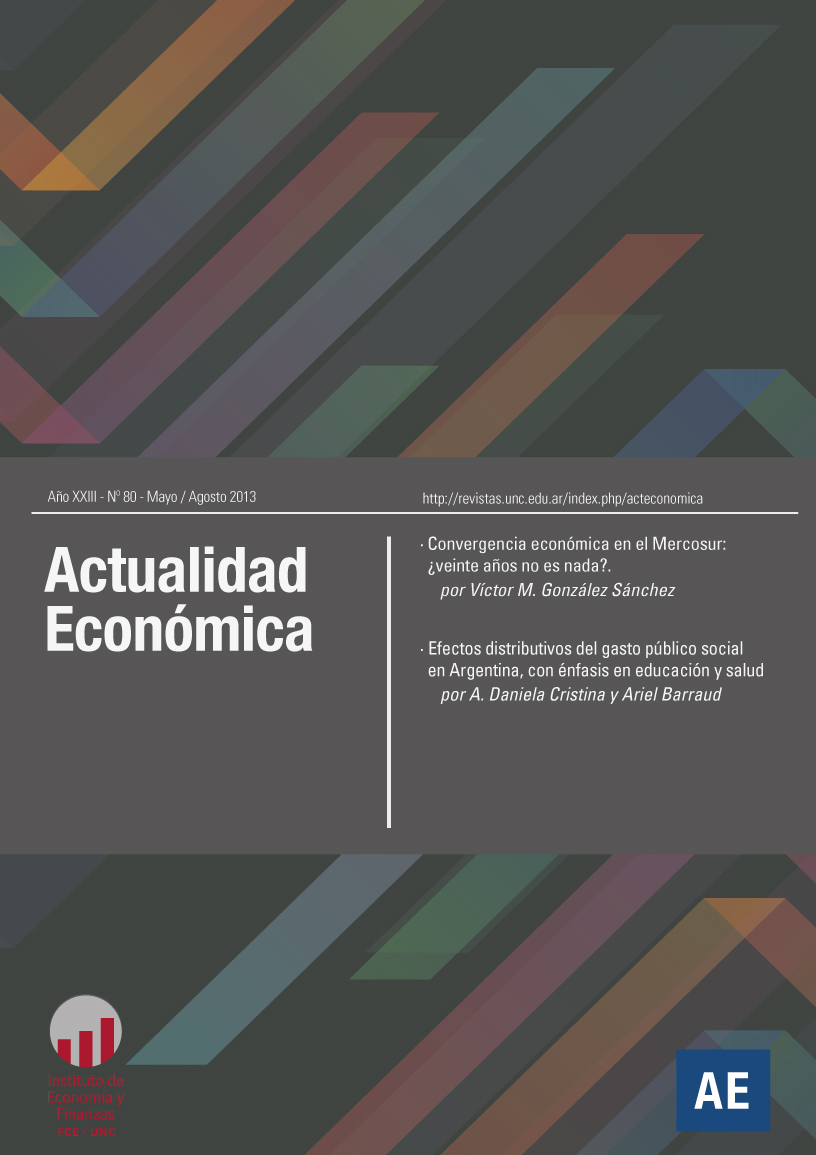Distributional effects of public social spending in Argentina, with emphasis on education and health
Keywords:
Public social expenditure , Income distribution , Distributive incidenceAbstract
This paper analyzes the distributive incidence of Public and Social Expenditure in Argentina, using the approach of the incidence of the benefits of spending. The analysis shows that all expenditure items are progressive, that is, their distribution is more equitable than the distribution of income, and therefore tend to improve it. An analysis of the distribution of educational levels shows that the same thing happens with the different levels of education spending. At the same time, considering different tax structures, it is observed that Social Public Expenditure improves the distribution of income in Argentina, even when the possibility of verifying a regressive tax structure is considered. This is so because both under a proportional tax structure and a regressive tax structure, State intervention increases equity in the distribution of income, although the effect is less if the State is financed by regressive taxes.
Downloads
References
Champernowne, D. y Cowell, F. (1998). Economic inequality and income distribution. Cambridge University Press.
Cruces, Guillermo y Leonardo Gasparini (2008). “Programas Sociales en Argentina: Alternativas para la Ampliación de la Cobertura”. Working Papers 0077, CEDLAS, Universidad Nacional de La Plata.
Demery, L.(2003). Analyzing the Incidence of Public Spending, The Impact of Economic Policies on Poverty and Income Distribution: Evaluation Techniques and Tools. L. A. Pereira da Silva y F. Bourguignon, eds. World Bank y Oxford University Press.
Gasparini, L. y Porto, A. (1991). “Impacto distributivo del gasto social”. Desarrollo Económico 31 (124).
Gasparini, L., Marchioni, M. y Sosa Escudero, W. (2001). Distribución del ingreso en la. Argentina: perspectivas y efectos sobre el bienestar. Fundación Arcor.
Gasparini, L. (1999). Incidencia distributiva del gasto público social y de la política tributaria en Argentina. En FIEL, La distribución del ingreso en Argentina, cap. V.1. Buenos Aires.
Harriague, M. y L. Gasparini (1999). “El impacto redistributivo del gasto público en los sectores sociales”. Anales de la Asociación Argentina de Economía Política.
INDEC, estadísticas varias.
Kaplow, L. (2002). “Why measure inequality?” NBER Working Paper Series 9342.
Lambert, P. (1993). The distribution and redistribution of income: a mathematical analysis. Segunda edición. Redwood Books, Gran Bretaña.
León, A. (1998). “Las encuestas de hogares como fuente de información para el análisis de la educación y sus vínculos con el bienestar y la equidad”. Serie Políticas Sociales 22. CEPAL.
Llach, J. y S. Montoya (1999). “En pos de la equidad. La pobreza y la distribución del ingreso en el Área Metropolitana del Gran Buenos Aires: diagnóstico y alternativas de políticas”. IERAL.
Martinez-Vazquez, J. (2001).”The Impact of Budgets on the Poor: Tax and Benefit Incidence”. International Studies Program Working Paper Series 01-10, Andrew Young School of Policy Studies, Georgia State University.
Musgrave, R. (1989). Public Finance in Theory and Practice. McGraw Hill Book Company, New York.
Seijas, L., M. Moreno y W. González (2003). “La incidencia fiscal neta en Venezuela”. Serie Documentos de Trabajo Nº 48. Colección Banca Central y Sociedad. Banco Central de Venezuela.
Shorrocks, A. (1983). “Ranking Income Distributions. Economica”, New Series, Vol. 50, No. 197 (Feb.), pp. 3-17.
Downloads
Published
Issue
Section
License

This work is licensed under a Creative Commons Attribution-NonCommercial-NoDerivatives 4.0 International License.
Those authors who have published with this journal, accept the following terms:
Authors will conserve their copyright and guarantee the magazine the right of first publication of their work, which will be simultaneously subject to the Creative Commons Attribution-NonCommercial-NoDerivative 4.0 International License that allows third parties to share the work as long as the author and first publication of this magazine are indicated.
Authors may adopt other non-exclusive license agreements to distribute the published version of the work (e.g., deposit it in an institutional telematic archive or publish it in a monographic volume) provided that the initial publication in this journal is indicated.
Authors are allowed and encouraged to disseminate their work through the Internet (e.g., in institutional telematic archives or on their website) before and during the submission process, which may lead to interesting exchanges and increase citations of the published work. (See The effect of open access)









